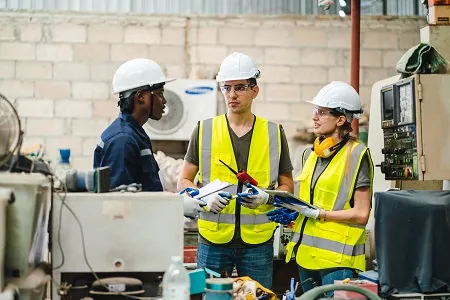Industry Standards Are Constantly Evolving
As we know there are no industries that remain static, laws change, technologies advance and best practices shift. Employees who were trained a year or two ago may no longer be following the most current guidelines.
For example:
- Work Health and Safety (WHS) laws in Australia require employers to provide regular training to ensure ongoing compliance.
- Cybersecurity threats evolve, requiring continuous updates on safe online practices.
- Technological advancements mean that employees must be regularly trained to use new software or tools safely and efficiently.
Without retraining, employees may unknowingly violate new regulations or fail to take advantage of improved tools and processes.
1.1 Employee Habits Can Become Inefficient
Over time, even the most well-trained employees can develop shortcuts or personal workarounds that may not align with best practices. While some of these adaptations may be harmless, others can lead to inefficiencies or even safety hazards.
For instance, an employee in a warehouse may have developed a habit of lifting heavy boxes improperly, putting themselves at risk of injury. A customer service representative might be handling complaints based on outdated policies. Retraining ensures that employees are following the best, most efficient and safest methods rather than relying on old habits.
1.2 Compliance and Risk Management
Australian businesses must adhere to strict compliance regulations, especially in industries like healthcare, construction, and finance. Failure to provide regular training can lead to legal liabilities, financial penalties, and reputational damage.
By implementing Rapid Induction setup by Induct For Work, organisations can ensure that employees complete their online inductions on a regular basis, maintaining up-to-date certifications and compliance records. The system automatically tracks completion rates, sends reminders, and provides real-time compliance monitoring, reducing the risk of non-compliance.
Key Benefits of Regular Employee Retraining
2.1. Improved Workplace Safety
A well-trained workforce is a safer workforce. Employees who receive regular training on WHS regulations, emergency procedures and hazard identification are far less likely to cause or experience workplace accidents.
Consider the example of a construction site where workers use heavy machinery. If workers fail to receive refresher training on proper handling and safety protocols, the likelihood of injury increases significantly. With an efficient online induction system, businesses can ensure that all workers receive the latest safety briefings without the need for time-consuming in-person training.
2.2. Higher Productivity and Efficiency
Well-trained employees complete tasks more quickly and with fewer mistakes. When workers stay up to date with the latest software, best practices and industry developments, they can work smarter—not harder.
For example, businesses using Rapid Induction Setup by Induct For Work can have their online inductions accounts up and running in no time, integrate their role-specific training modules that allow employees to focus only on relevant skills, eliminating unnecessary downtime and confusion.
2.3. Increased Employee Engagement and Retention
Employees who feel that their company invests in their growth and development are far more likely to remain loyal to the organisation. A lack of training can lead to frustration, stagnation, and ultimately higher turnover rates.
Regular retraining provides employees with opportunities to learn new skills, stay engaged and advance their careers. With online inductions, businesses can offer personalised learning experiences that cater to different job roles and skill levels, ensuring each employee gets the training they need to succeed.
2.4. Consistency Across the Organisation
Standardised retraining ensures that all employees receive the same level of education, understand company policies and follow best practices. This is especially important for organisations with multiple locations, remote teams, or a mix of full-time, part-time and contract workers.
A cloud-based induction system Induct For Work, allows businesses to create consistent, easily accessible training programs that can be completed anytime, anywhere.

How to Implement a Strong Retraining Program
3.1. Assess Training Gaps
Before rolling out a retraining program, organisations should assess where gaps exist. This can be done through:
- Employee feedback surveys
- Performance evaluations
- Compliance audits
- Incident reports (e.g., workplace accidents, IT security breaches, customer complaints)
These insights help businesses tailor their retraining programs to focus on areas that need improvement.
3.2. Use Online Inductions for Flexibility and Scalability
Traditional classroom-based training can be expensive, time-consuming, and impractical—especially for companies with distributed teams. Online inductions provide a cost-effective and scalable alternative, allowing employees to complete training at their own pace without disrupting their workflow.
With Rapid Induction Setup by Induct For Work, companies can:
- Setup their accounts with little effort
- Create and update training modules easily
- Automate compliance tracking
- Offer mobile-friendly learning experiences
- Provide instant certification upon completion
3.3. Set Regular Retraining Intervals
Training should not be a one-time event. Organisations should establish clear retraining schedules, such as:
- Every 12 months for WHS and compliance training
- Every time a major policy, law or technology changes
- Before employees take on new responsibilities or roles
3.4. Make Training Engaging
One reason employees dread retraining is that it often feels repetitive or dull. Using engaging content formats such as videos, quizzes, simulations and real-world scenarios, you can significantly improve retention and participation.
Induct For Work’s online induction platform enables organisations to incorporate multimedia content and interactive exercises into their training, making learning more engaging and effective.
3.5. Monitor and Evaluate Training Effectiveness
Simply delivering training is not enough—businesses must measure its impact. HR and training managers should:
- Track training completion rates
- Analyse quiz scores and assessments
- Review employee performance post-training
- Gather feedback on training effectiveness
If employees struggle with certain topics or report training as ineffective, businesses can adjust their approach to better meet their needs.
Final Words
Prioritising Retraining for Long-Term Success.
Retraining employees is not just about ticking compliance boxes, it’s about fostering a safety culture of continuous improvement, safety and efficiency. Businesses that fail to update their employees’ knowledge risk falling behind competitors, increasing workplace accidents and facing regulatory penalties.
With Induct For Work, companies can streamline the retraining process, automate compliance tracking and ensure employees remain up to date with the latest best practices. By leveraging the power of online inductions, organisations create a more engaged, well-trained and productive workforce, setting the stage for long-term success.
In a fast-changing business landscape, staying ahead means learning continuously. Make employee retraining a priority today and watch your organisation thrive tomorrow.

Inducting new employees plays a vital role in the smooth, safe and efficient running of an organisation, but retraining existing employees is just as crucial
Both inductions and retraining sessions ensure employees are made aware – and remain aware – of the latest rules, regulations, practices and behaviours within an industry and, more importantly, within your organisation and, by regularly retraining staff, you’ll ensure their knowledge is never out of date.
You’ll also be able to provide a refresher as to how things are supposed to be done, which is helpful for long-term staff members who sometimes fall into their own routines of doing things, which aren’t always the best or most efficient ways of doing things, especially if other staff members are picking up their bad habits or shortcuts!
So, here are the main reasons you should absolutely and regularly retrain existing employees rather than merely focussing all your training efforts of new recruits:
- Retraining existing employees has a cumulative effect. The more effort you put into retraining them, the less time you need to spend retraining them! They already have knowledge of your organisation, the culture and day-to-day work processes, so retraining an existing employee is often faster than inducting a new employee, which can, often, take days or weeks.
- As an employer, you can target your training specifically to the needs of the group or individual being retrained. When a new employee joins a business, the induction provided is very generic and, generally, covers the business broadly, as well as their role more specifically. However, with re-training, you know the employees, their strengths and weaknesses and what they do well, as well as what skill sets need work. You can, therefore, choose training that is targeted to their specific needs which, in the long term, will help your business meet its future operational requirements.
- Retraining can motivate existing employees who may have fallen into a rut within their roles. By improving their knowledge of their area of work, you should be able to improve the calibre of whatever they are responsible for outputting within the company. This can also lead to productivity gains.
- Retraining shows your workforce that you value them. It proves that you, as their employer, are willing to invest time, money and effort into improving them and their skill sets. This, often, leads to greater productivity and a genuine sense of loyalty which, in turn, improves staff retention and reduces staff turnover.
- Retraining employees can bring with it not only increased job satisfaction, it can actually improve morale amongst employees who will, inevitably, perform their roles more competently – and with more confidence and satisfaction.
- Retraining can provide a level of risk management among your workforce, particularly in areas such as sexual harassment, diversity and, of course, safety. By ensuring your employees know what is right and wrong within a workplace, and that they follow those procedures, you reduce their chances of actually doing something wrong or acting inappropriately (or illegally), while reducing your own potential liability.
Retraining isn’t just about re-enforcing things your existing employees already know. It’s also about upskilling them personally. Yes, this adds to their overall contribution within your organisation, but it can also help build their confidence and their prospects of, perhaps, being promoted which, generally, brings with it the prospect of greater pay.
In turn, it can lead to more motivated, productive and happy employees – and that is something that genuinely benefits both the employee – and his/her employer.
Do you have any questions or great tips to share?
Induct for Work – the only online induction system you would need to run online inductions.



